Zhize Wu
DenseLoRA: Dense Low-Rank Adaptation of Large Language Models
May 27, 2025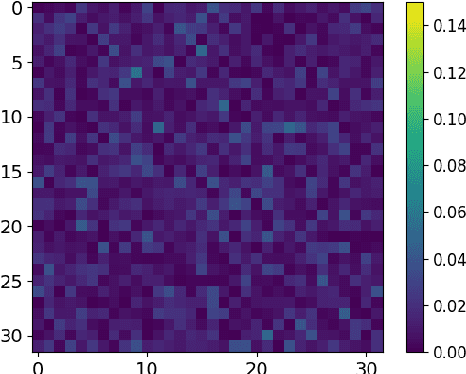
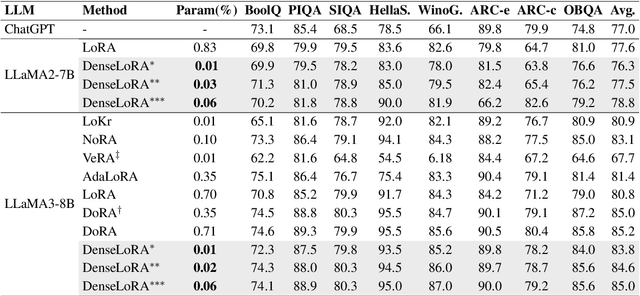
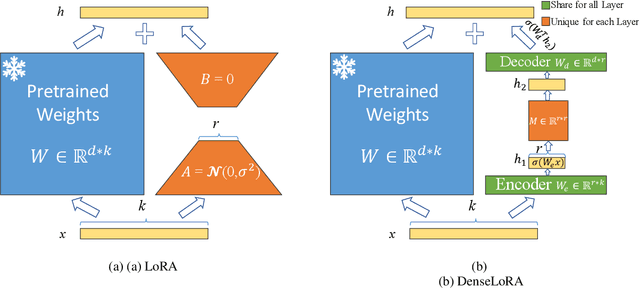

Abstract:Low-rank adaptation (LoRA) has been developed as an efficient approach for adapting large language models (LLMs) by fine-tuning two low-rank matrices, thereby reducing the number of trainable parameters. However, prior research indicates that many of the weights in these matrices are redundant, leading to inefficiencies in parameter utilization. To address this limitation, we introduce Dense Low-Rank Adaptation (DenseLoRA), a novel approach that enhances parameter efficiency while achieving superior performance compared to LoRA. DenseLoRA builds upon the concept of representation fine-tuning, incorporating a single Encoder-Decoder to refine and compress hidden representations across all adaptation layers before applying adaptation. Instead of relying on two redundant low-rank matrices as in LoRA, DenseLoRA adapts LLMs through a dense low-rank matrix, improving parameter utilization and adaptation efficiency. We evaluate DenseLoRA on various benchmarks, showing that it achieves 83.8% accuracy with only 0.01% of trainable parameters, compared to LoRA's 80.8% accuracy with 0.70% of trainable parameters on LLaMA3-8B. Additionally, we conduct extensive experiments to systematically assess the impact of DenseLoRA's components on overall model performance. Code is available at https://github.com/mulin-ahu/DenseLoRA.
Imperceptible Adversarial Attacks on Point Clouds Guided by Point-to-Surface Field
Dec 26, 2024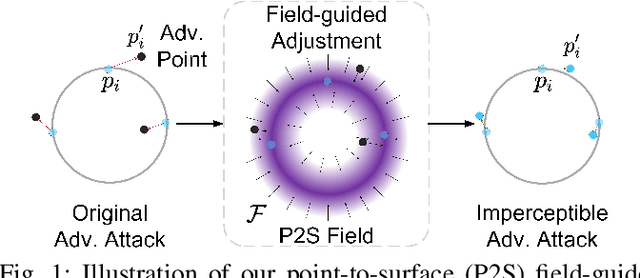
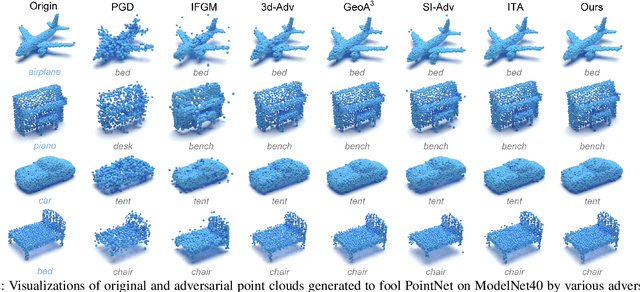

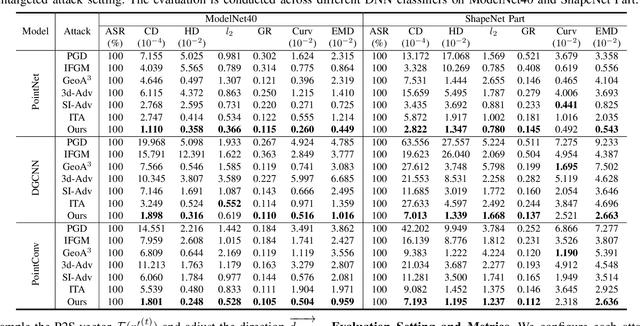
Abstract:Adversarial attacks on point clouds are crucial for assessing and improving the adversarial robustness of 3D deep learning models. Traditional solutions strictly limit point displacement during attacks, making it challenging to balance imperceptibility with adversarial effectiveness. In this paper, we attribute the inadequate imperceptibility of adversarial attacks on point clouds to deviations from the underlying surface. To address this, we introduce a novel point-to-surface (P2S) field that adjusts adversarial perturbation directions by dragging points back to their original underlying surface. Specifically, we use a denoising network to learn the gradient field of the logarithmic density function encoding the shape's surface, and apply a distance-aware adjustment to perturbation directions during attacks, thereby enhancing imperceptibility. Extensive experiments show that adversarial attacks guided by our P2S field are more imperceptible, outperforming state-of-the-art methods.
DAFD: Domain Adaptation via Feature Disentanglement for Image Classification
Jan 30, 2023



Abstract:A good feature representation is the key to image classification. In practice, image classifiers may be applied in scenarios different from what they have been trained on. This so-called domain shift leads to a significant performance drop in image classification. Unsupervised domain adaptation (UDA) reduces the domain shift by transferring the knowledge learned from a labeled source domain to an unlabeled target domain. We perform feature disentanglement for UDA by distilling category-relevant features and excluding category-irrelevant features from the global feature maps. This disentanglement prevents the network from overfitting to category-irrelevant information and makes it focus on information useful for classification. This reduces the difficulty of domain alignment and improves the classification accuracy on the target domain. We propose a coarse-to-fine domain adaptation method called Domain Adaptation via Feature Disentanglement~(DAFD), which has two components: (1)the Category-Relevant Feature Selection (CRFS) module, which disentangles the category-relevant features from the category-irrelevant features, and (2)the Dynamic Local Maximum Mean Discrepancy (DLMMD) module, which achieves fine-grained alignment by reducing the discrepancy within the category-relevant features from different domains. Combined with the CRFS, the DLMMD module can align the category-relevant features properly. We conduct comprehensive experiment on four standard datasets. Our results clearly demonstrate the robustness and effectiveness of our approach in domain adaptive image classification tasks and its competitiveness to the state of the art.
New Benchmark for Household Garbage Image Recognition
Feb 24, 2022
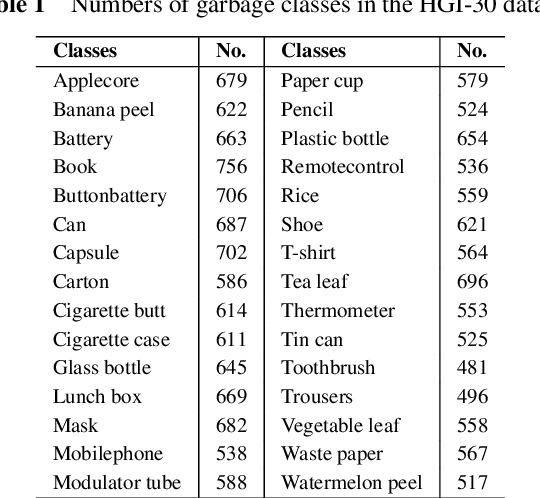
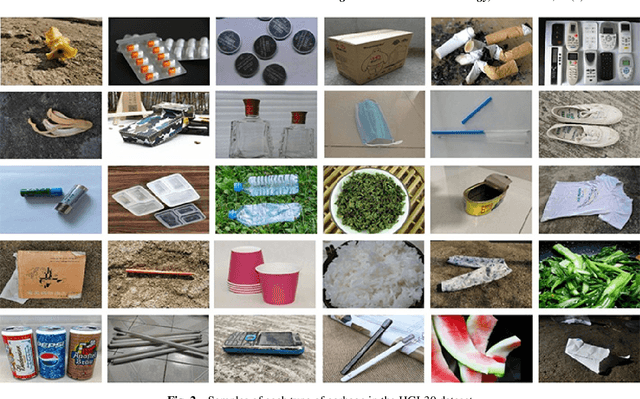
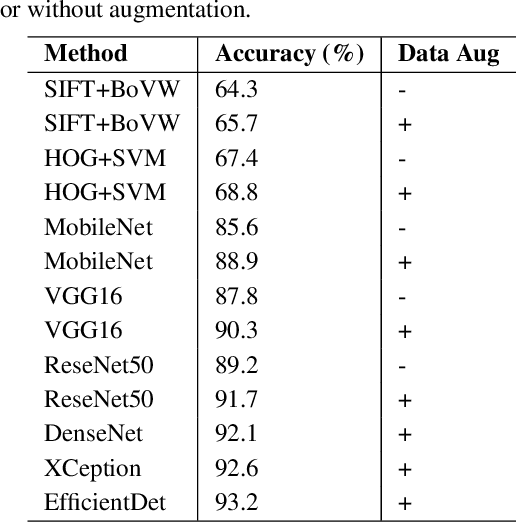
Abstract:Household garbage images are usually faced with complex backgrounds, variable illuminations, diverse angles, and changeable shapes, which bring a great difficulty in garbage image classification. Due to the ability to discover problem-specific features, deep learning and especially convolutional neural networks (CNNs) have been successfully and widely used for image representation learning. However, available and stable household garbage datasets are insufficient, which seriously limits the development of research and application. Besides, the state of the art in the field of garbage image classification is not entirely clear. To solve this problem, in this study, we built a new open benchmark dataset for household garbage image classification by simulating different lightings, backgrounds, angles, and shapes. This dataset is named 30 Classes of Household Garbage Images (HGI-30), which contains 18,000 images of 30 household garbage classes. The publicly available HGI-30 dataset allows researchers to develop accurate and robust methods for household garbage recognition. We also conducted experiments and performance analysis of the state-of-the-art deep CNN methods on HGI-30, which serves as baseline results on this benchmark.
Domain-Invariant Proposals based on a Balanced Domain Classifier for Object Detection
Feb 12, 2022


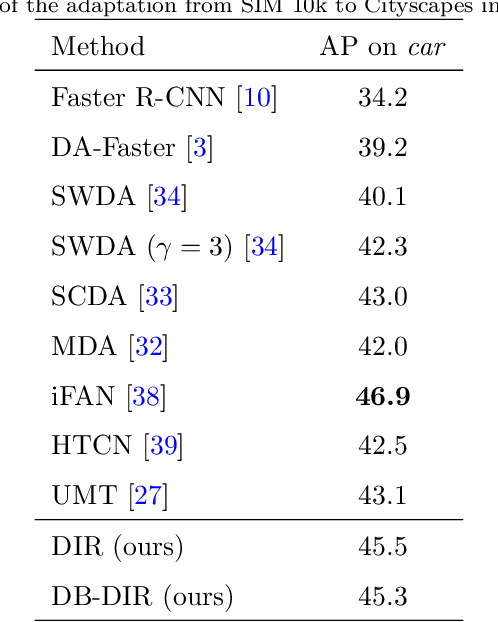
Abstract:Object recognition from images means to automatically find object(s) of interest and to return their category and location information. Benefiting from research on deep learning, like convolutional neural networks~(CNNs) and generative adversarial networks, the performance in this field has been improved significantly, especially when training and test data are drawn from similar distributions. However, mismatching distributions, i.e., domain shifts, lead to a significant performance drop. In this paper, we build domain-invariant detectors by learning domain classifiers via adversarial training. Based on the previous works that align image and instance level features, we mitigate the domain shift further by introducing a domain adaptation component at the region level within Faster \mbox{R-CNN}. We embed a domain classification network in the region proposal network~(RPN) using adversarial learning. The RPN can now generate accurate region proposals in different domains by effectively aligning the features between them. To mitigate the unstable convergence during the adversarial learning, we introduce a balanced domain classifier as well as a network learning rate adjustment strategy. We conduct comprehensive experiments using four standard datasets. The results demonstrate the effectiveness and robustness of our object detection approach in domain shift scenarios.
Frequency Fitness Assignment: Optimization without a Bias for Good Solutions can be Efficient
Dec 02, 2021
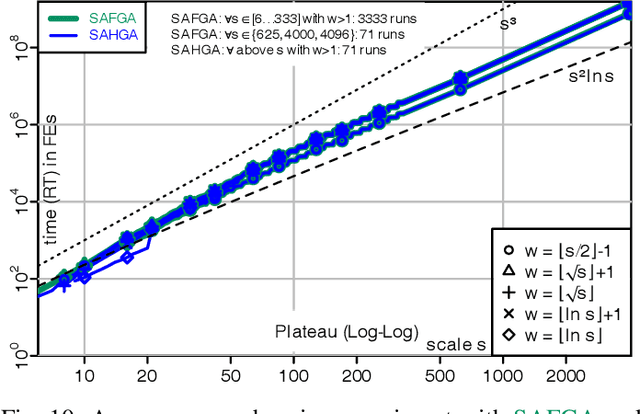


Abstract:A fitness assignment process transforms the features (such as the objective value) of a candidate solution to a scalar fitness, which then is the basis for selection. Under Frequency Fitness Assignment (FFA), the fitness corresponding to an objective value is its encounter frequency and is subject to minimization. FFA creates algorithms that are not biased towards better solutions and are invariant under all bijections of the objective function value. We investigate the impact of FFA on the performance of two theory-inspired, state-of-the-art EAs, the Greedy (2+1) GA and the Self-Adjusting (1+(lambda,lambda)) GA. FFA improves their performance significantly on some problems that are hard for them. We empirically find that one FFA-based algorithm can solve all theory-based benchmark problems in this study, including traps, jumps, and plateaus, in polynomial time. We propose two hybrid approaches that use both direct and FFA-based optimization and find that they perform well. All FFA-based algorithms also perform better on satisfiability problems than all pure algorithm variants.
Skeleton Based Action Recognition using a Stacked Denoising Autoencoder with Constraints of Privileged Information
Mar 12, 2020

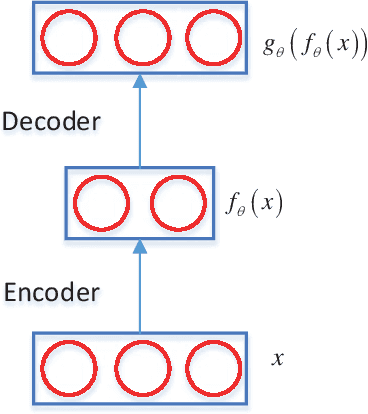

Abstract:Recently, with the availability of cost-effective depth cameras coupled with real-time skeleton estimation, the interest in skeleton-based human action recognition is renewed. Most of the existing skeletal representation approaches use either the joint location or the dynamics model. Differing from the previous studies, we propose a new method called Denoising Autoencoder with Temporal and Categorical Constraints (DAE_CTC)} to study the skeletal representation in a view of skeleton reconstruction. Based on the concept of learning under privileged information, we integrate action categories and temporal coordinates into a stacked denoising autoencoder in the training phase, to preserve category and temporal feature, while learning the hidden representation from a skeleton. Thus, we are able to improve the discriminative validity of the hidden representation. In order to mitigate the variation resulting from temporary misalignment, a new method of temporal registration, called Locally-Warped Sequence Registration (LWSR), is proposed for registering the sequences of inter- and intra-class actions. We finally represent the sequences using a Fourier Temporal Pyramid (FTP) representation and perform classification using a combination of LWSR registration, FTP representation, and a linear Support Vector Machine (SVM). The experimental results on three action data sets, namely MSR-Action3D, UTKinect-Action, and Florence3D-Action, show that our proposal performs better than many existing methods and comparably to the state of the art.
Frequency Fitness Assignment: Making Optimization Algorithms Invariant under Bijective Transformations of the Objective Function
Jan 07, 2020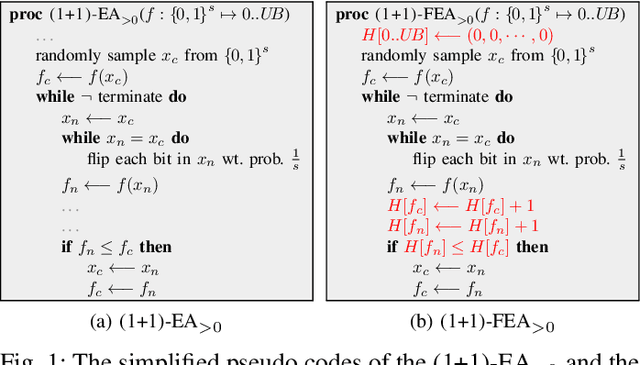
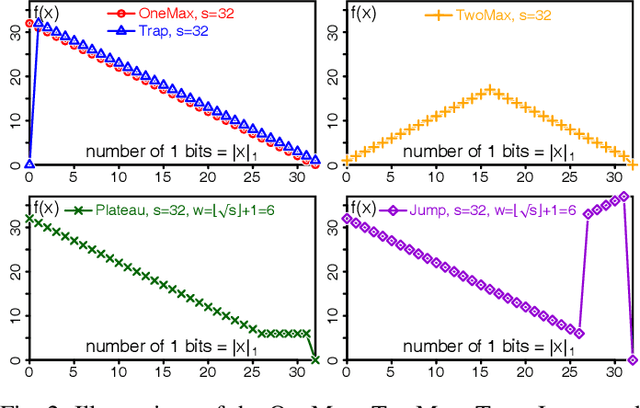
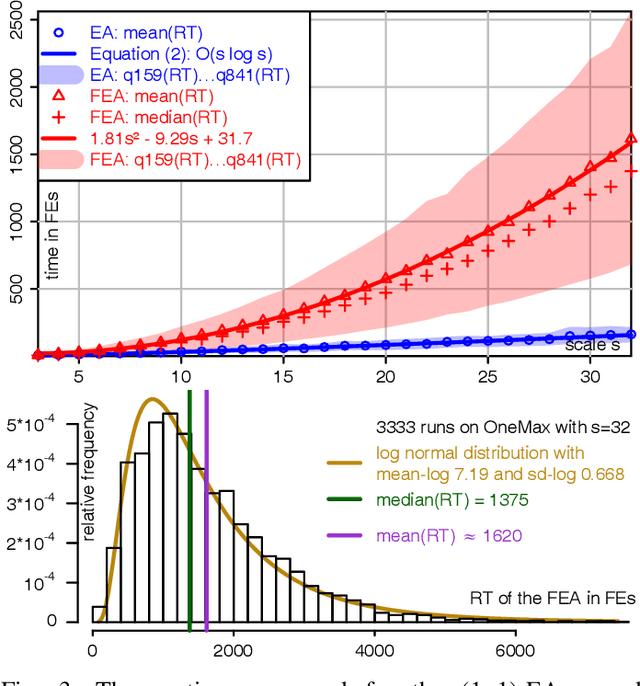
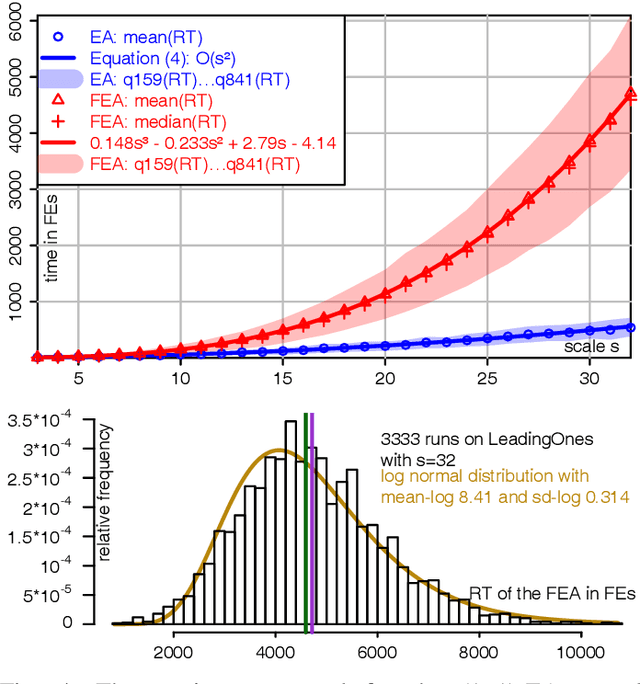
Abstract:Under Frequency Fitness Assignment (FFA), the fitness corresponding to an objective value is its encounter frequency in fitness assignment steps and is subject to minimization. FFA renders optimization processes invariant under bijective transformations of the objective function. This is the strongest invariance property of any optimization procedure to our knowledge. On TwoMax, Jump, and Trap functions of scale s, a (1+1)-EA with standard mutation at rate 1/s can have expected running times exponential in s. In our experiments, a (1+1)-FEA, the same algorithm but using FFA, exhibits mean running times quadratic in s. Since Jump and Trap are bijective transformations of OneMax, it behaves identical on all three. On the LeadingOnes and Plateau problems, it seems to be slower than the (1+1)-EA by a factor linear in s. The (1+1)-FEA performs much better than the (1+1)-EA on W-Model and MaxSat instances. Due to the bijection invariance, the behavior of an optimization algorithm using FFA does not change when the objective values are encrypted. We verify this by applying the Md5 checksum computation as transformation to some of the above problems and yield the same behaviors. Finally, FFA can improve the performance of a Memetic Algorithm for Job Shop Scheduling.
 Add to Chrome
Add to Chrome Add to Firefox
Add to Firefox Add to Edge
Add to Edge